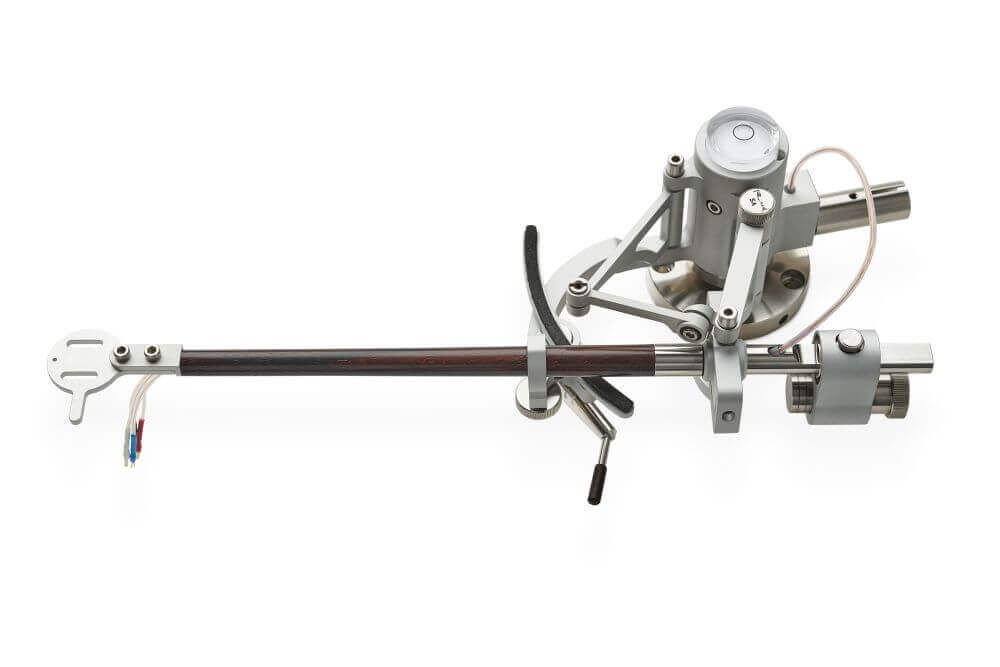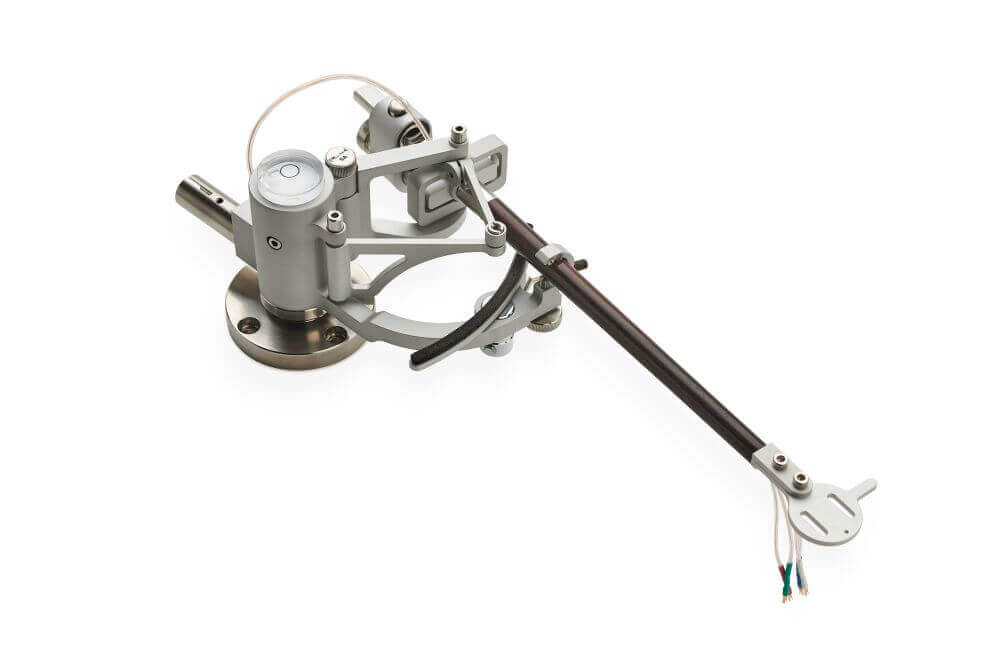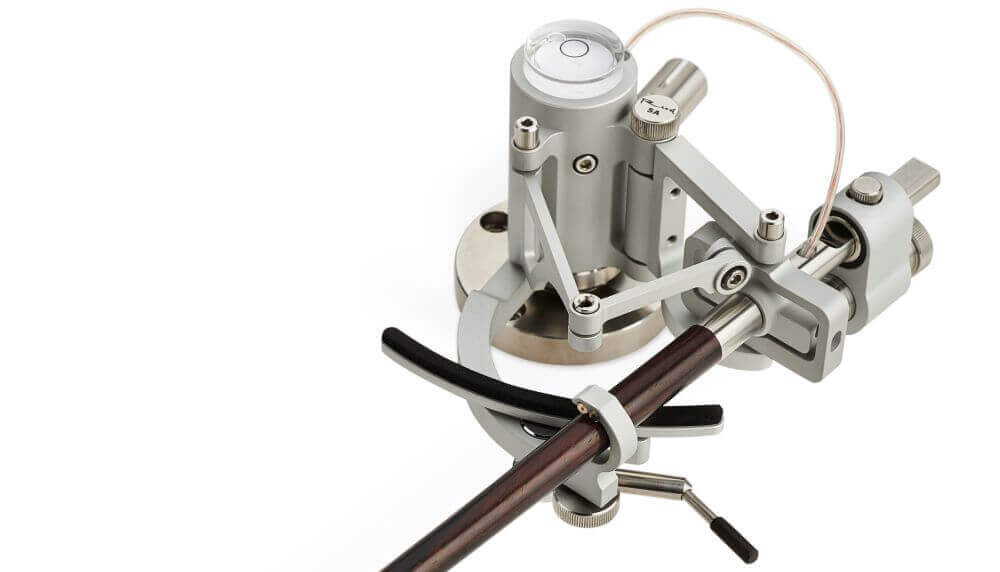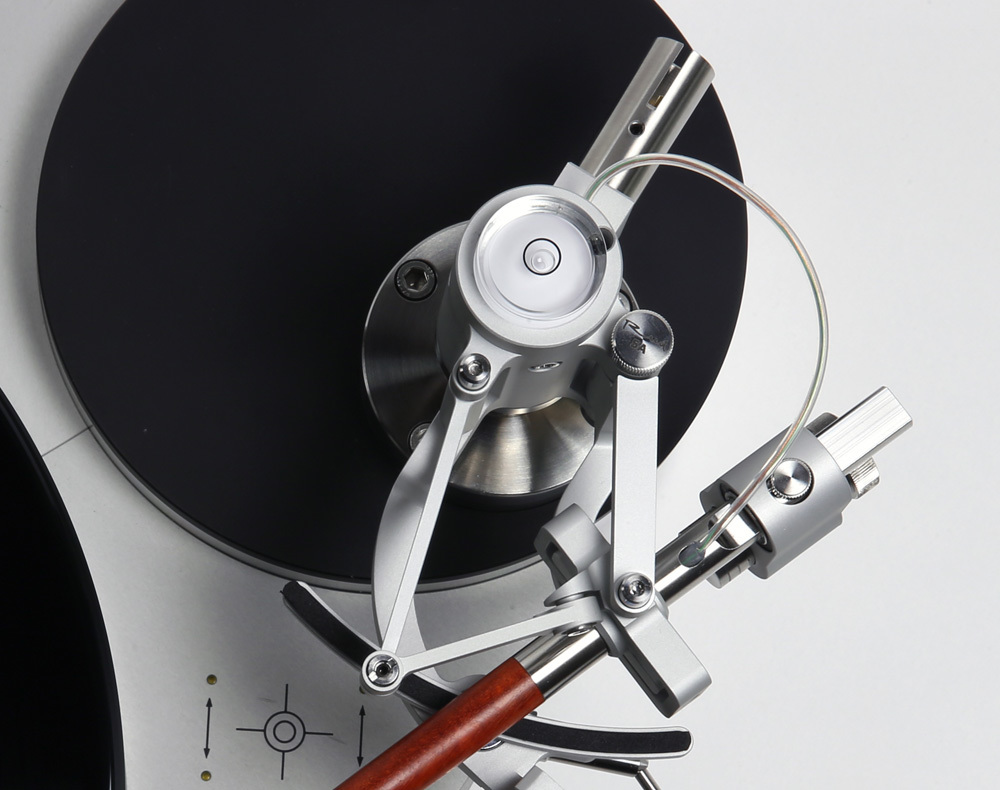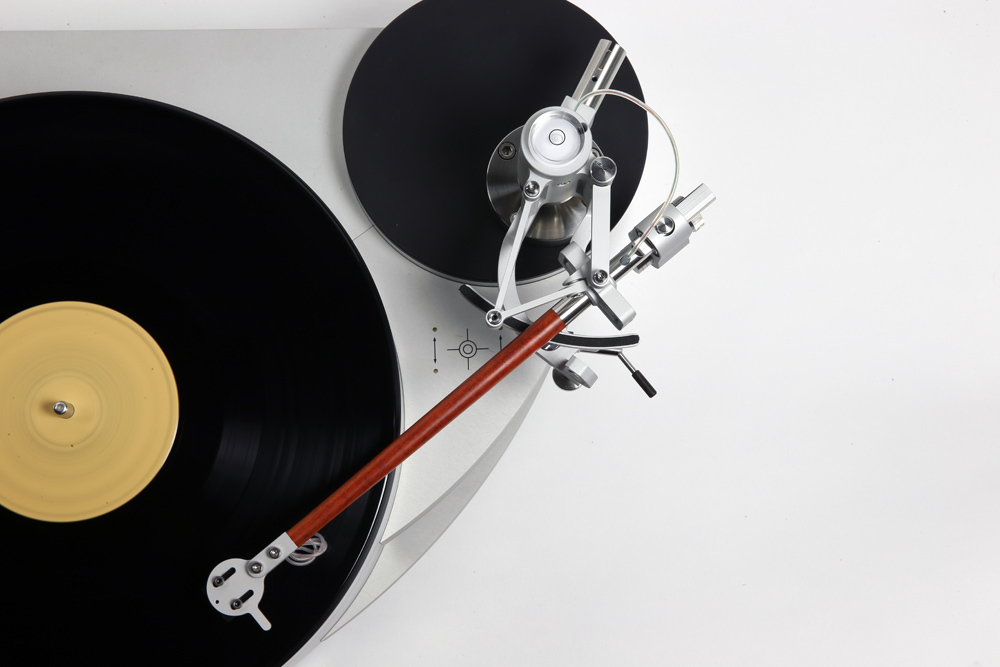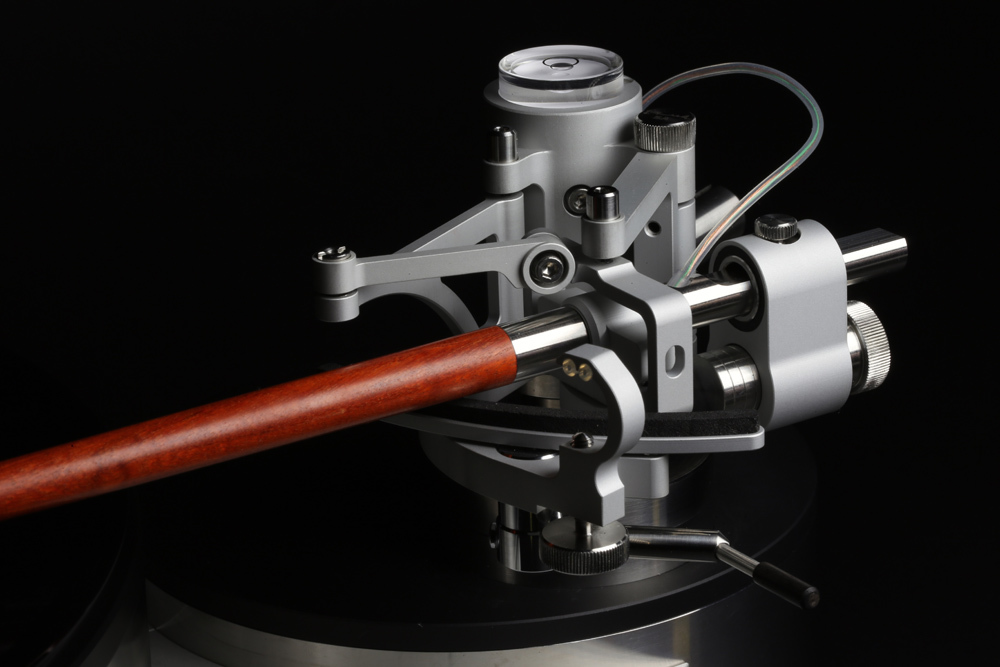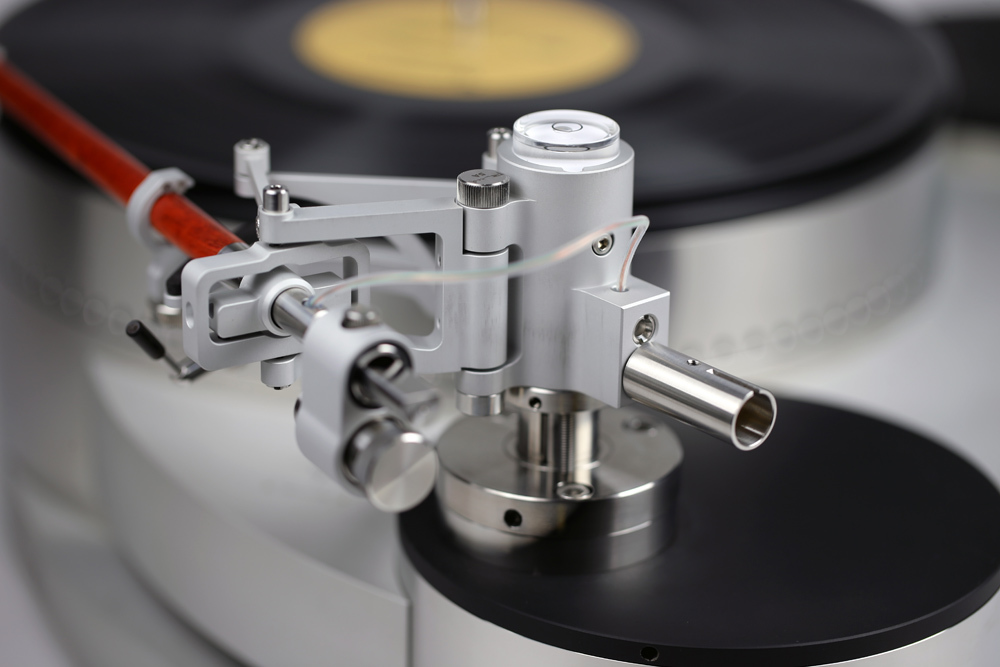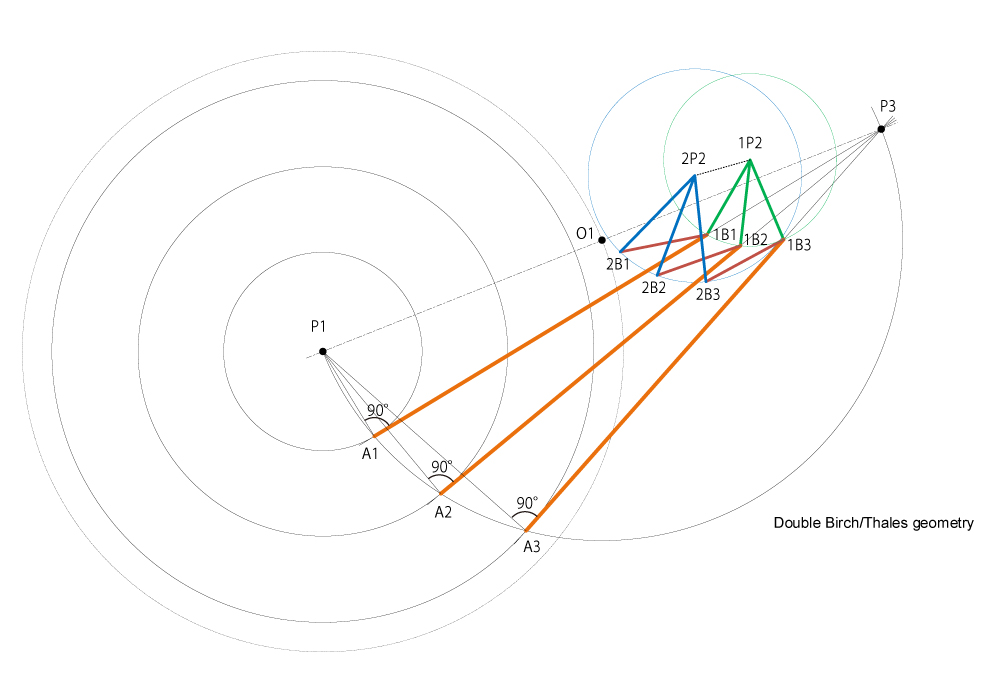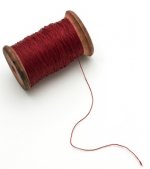Great video; but it would have been fairer a title like "the inventors behind Reed SA": Mr Thales, Mr Birch, Mr Tuthill.
Without the last, especially, no "double pivot Birch" replica: from my 3DToy up to the Reed SA included.
When using an idea, especially for commercial purposes, it would be nice at least to recognize the merits to the one who found it
carlo
Without the last, especially, no "double pivot Birch" replica: from my 3DToy up to the Reed SA included.
When using an idea, especially for commercial purposes, it would be nice at least to recognize the merits to the one who found it
carlo
Thiele TA01 tonearm
Another commercial product posted here and here using similar Birch geometry with a twist, claimed to be "ZERO Tracking Error Tonearm." The double pivoting goes in opposite directions so perhaps it can cancel out some skating force? Not sure... The brand was once named Vero and now it's Thiele.
Here are some fascinating pictures.




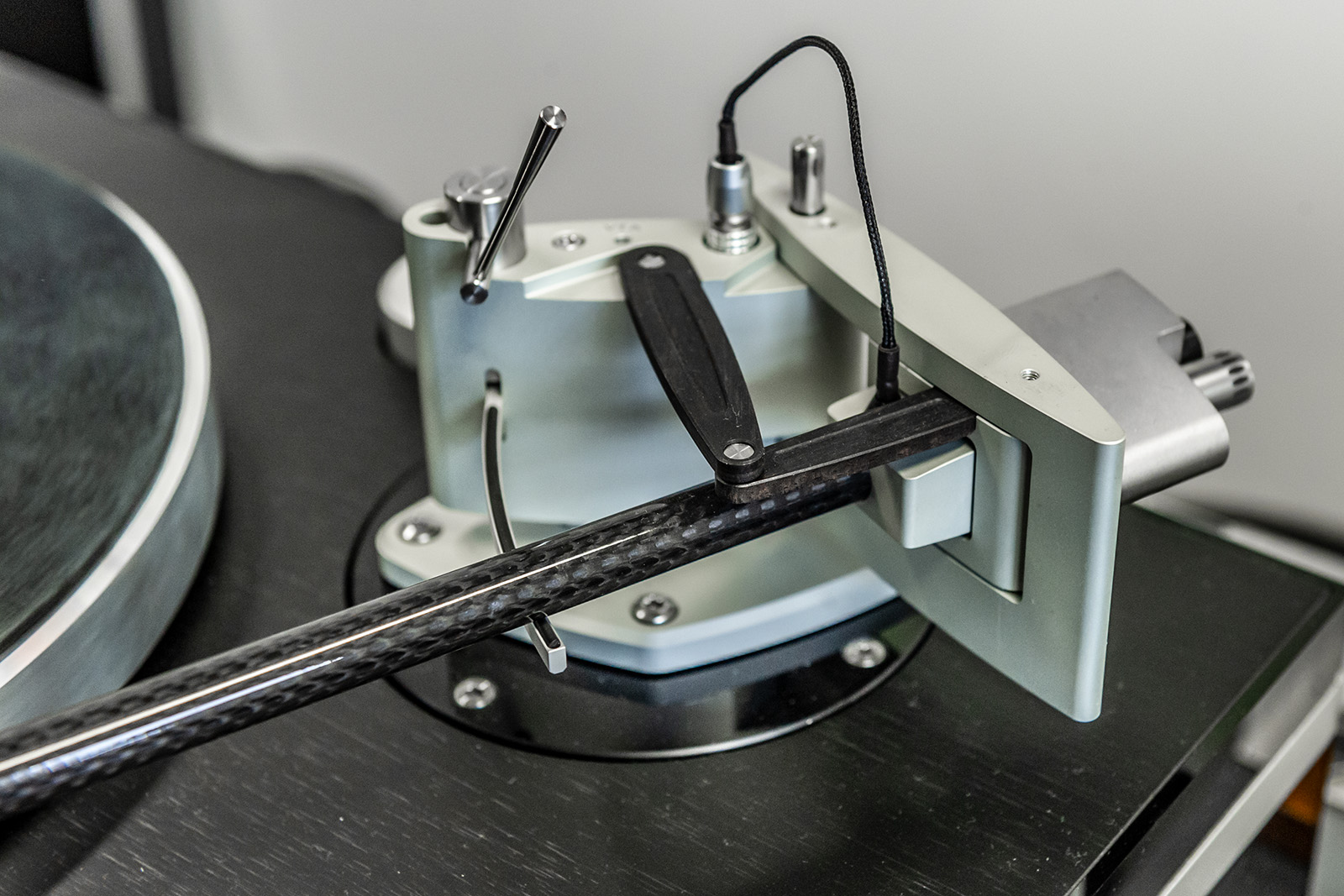

Early prototype
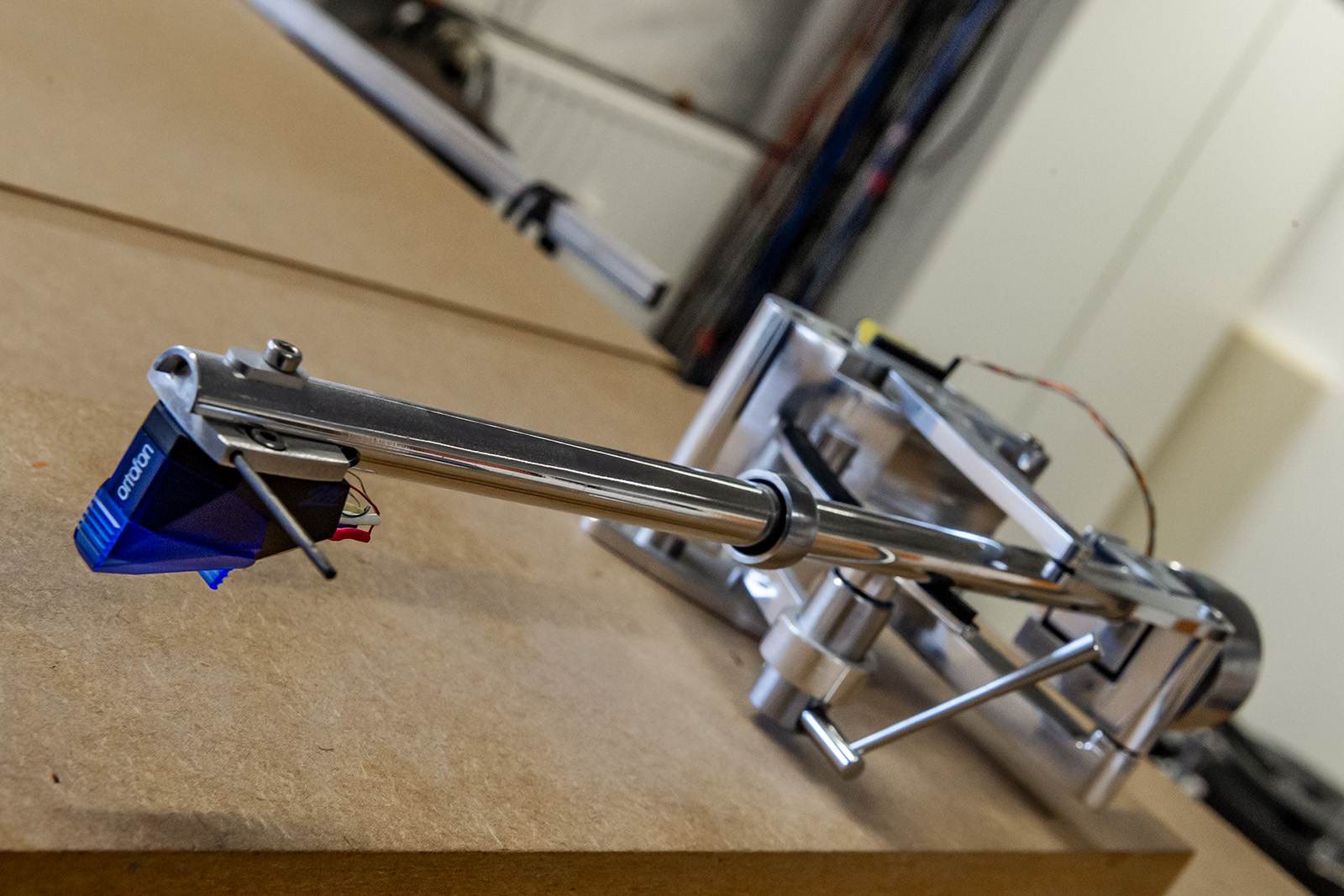
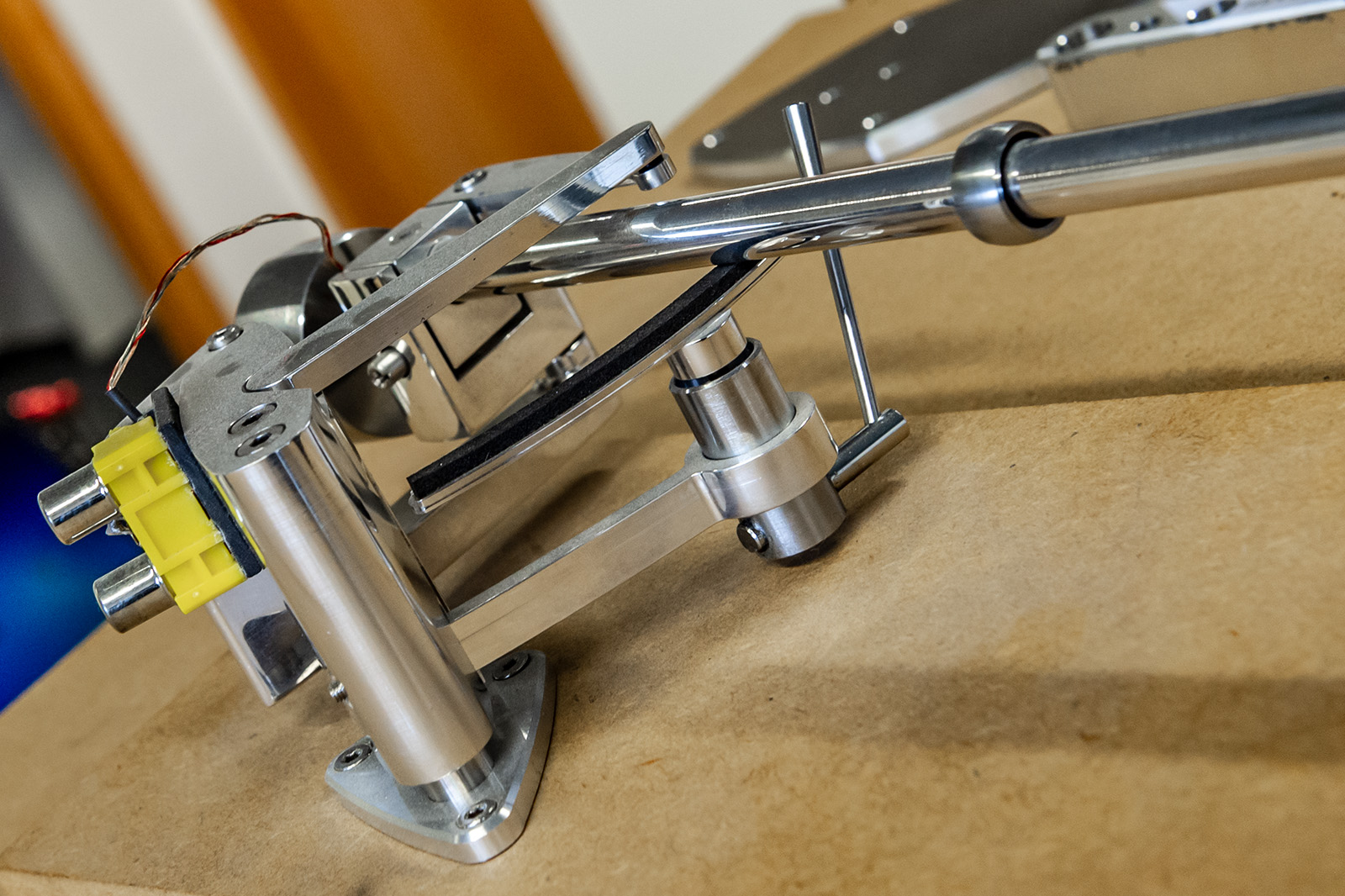
Another commercial product posted here and here using similar Birch geometry with a twist, claimed to be "ZERO Tracking Error Tonearm." The double pivoting goes in opposite directions so perhaps it can cancel out some skating force? Not sure... The brand was once named Vero and now it's Thiele.
Here are some fascinating pictures.






Early prototype


The double pivoting goes in opposite directions so perhaps it can cancel out some skating force?
Attachments
Re: the string test
Thank you Ray! I love always having you and the string test to keep us honest!
But the Thiele tonearm does show some promise that, if not eliminating skating force, it MIGHT minimize skating force more than others in the quasi-Birch genre of tonearms. To his credit, at least Thiele shows some inventiveness. I wish there's a posted video showing it in action.
I am also curious about the oddly shaped counterweight. What is that knob for? Hmmm... I bet leveling is important in an arm like this with multi-cantilevered linkages otherwise it would introduce more skating force than normal arm mounted on an unleveled surface.


Thank you Ray! I love always having you and the string test to keep us honest!
But the Thiele tonearm does show some promise that, if not eliminating skating force, it MIGHT minimize skating force more than others in the quasi-Birch genre of tonearms. To his credit, at least Thiele shows some inventiveness. I wish there's a posted video showing it in action.
I am also curious about the oddly shaped counterweight. What is that knob for? Hmmm... I bet leveling is important in an arm like this with multi-cantilevered linkages otherwise it would introduce more skating force than normal arm mounted on an unleveled surface.


This world never ceases to surprise me: once we small diyers tried to copy the ideas of the great manufacturers, often without fully understanding them, and today - funny - it happens the opposite.
A great proof- even if unintentional - of the importance of this (and other) forum, and of your meritorious work, direct driver.
carlo
A great proof- even if unintentional - of the importance of this (and other) forum, and of your meritorious work, direct driver.
carlo
I am also curious about the oddly shaped counterweight. What is that knob for? Hmmm... I bet leveling is important in an arm like this with multi-cantilevered linkages otherwise it would introduce more skating force than normal arm mounted on an unleveled surface.
IMO the knob is used to set VTF
What is that knob for? Hmmm...
To push/pull the CW, you can see the threads.
This world never ceases to surprise me: once we small diyers tried to copy the ideas of the great manufacturers, often without fully understanding them, and today - funny - it happens the opposite.
My PTT is done, has been for some time, and it might blow all your minds, but there is no way in hell I'll post it here for fear of the same treatment.
"borrowed" ideas
Ah, I see the protruding rod as the anchor so it's a dynamic balance type tonearm. It reminds me VTF adjustment of the Micro Seiki MA-505. Clever.
Congratulations! I bet it's awesome. Knowing how ingenious you are, I am prepared to have my mind blown in case we are fortunate enough to witness it. I also understand your concern, unfortunately. Perhaps some of the ideas and buzz words (Birch, angling, etc...) in this forum thread were aped, ahem, "borrowed" by some brands... Hey, it's flattering that people are paying attention!
To push/pull the CW, you can see the threads.
Ah, I see the protruding rod as the anchor so it's a dynamic balance type tonearm. It reminds me VTF adjustment of the Micro Seiki MA-505. Clever.
My PTT is done, has been for some time, and it might blow all your minds, but there is no way in hell I'll post it here for fear of the same treatment.
Congratulations! I bet it's awesome. Knowing how ingenious you are, I am prepared to have my mind blown in case we are fortunate enough to witness it. I also understand your concern, unfortunately. Perhaps some of the ideas and buzz words (Birch, angling, etc...) in this forum thread were aped, ahem, "borrowed" by some brands... Hey, it's flattering that people are paying attention!
My PTT is done, has been for some time, and it might blow all your minds, but there is no way in hell I'll post it here for fear of the same treatment. 2wice
Congratulations, 2wice - I guess you've ended up your fascinating hypothesis, characterized by a flawless geometry, you were working on some time ago. I think it required a very sophisticated design and construction.
Diyaudio is conceived to openly share our ideas and this is its first point of strength, but the other, decisive, is to fairly recognize and declare the merits of others, especially when we intend to use them. Ethics that unfortunately does not seem to belong to some external "visitor".
Personally, I console myself by comparing the realizations and observing the traps (geometries, masses distribution, bearings location) in which Doug, who had invented the bi-pivots geometry (and even my simple 3D printable version) had carefully tried not to fall.
carlo
Congratulations, 2wice - I guess you've ended up your fascinating hypothesis, characterized by a flawless geometry, you were working on some time ago. I think it required a very sophisticated design and construction.
Diyaudio is conceived to openly share our ideas and this is its first point of strength, but the other, decisive, is to fairly recognize and declare the merits of others, especially when we intend to use them. Ethics that unfortunately does not seem to belong to some external "visitor".
Personally, I console myself by comparing the realizations and observing the traps (geometries, masses distribution, bearings location) in which Doug, who had invented the bi-pivots geometry (and even my simple 3D printable version) had carefully tried not to fall.
carlo
Thanks, I will share here, just waiting for confirmation of the IP protection and a local vendor would like to view. I think you will like the solution. A part of the application might also benefit normal tonearms.
It's good to see Dr. DD is still on the case and has revived this almost moribund thread.
I gave serious thought to securing IP protection and attempting to manufacture a two-arm PLT, but the more I thought about everything that would be involved in starting a business like that - even after coming up with a precise, replicable working design - I decided it just wasn't for me. Beyond that, the whole purpose of this site and thread is to make it possible for amateurs to build good innovative gear and I didn't want to raise any barriers to that.
I am pleased that commercial builders have taken an interest in the two-arm design and I like what I'm seeing in both these efforts, although visually I prefer the delicacy of the Reed.
There was a lot of input from this thread that made the two-arm possible. Frank Schroeder was very generous with details and advice about his PLT, which encouraged me to enter this peculiar geometrical world. At some point, DD mentioned the possibilities of parallelograms, which helped me understand what I was seeing in my accidental drawing. Several people with better math skills than me analyzed what is going on with different geometries that have been proposed and improved the precision.
Then Carlo came along and just ran with the idea while 2wice continues to be a source of fascinating suggestions and designs. I am really looking forward to seeing what he posts. And diyrayk is always there holding a piece of string.
This post has wandered off in unexpected directions and a lot of valuable posters haven't been mentioned. I hope I haven't offended anyone.
I've been lurking here and at the linear tracker thread, but rarely posted because other parts of my life began to interfere with building. I still enjoy seeing the ingenious work of other members of the community.
I gave serious thought to securing IP protection and attempting to manufacture a two-arm PLT, but the more I thought about everything that would be involved in starting a business like that - even after coming up with a precise, replicable working design - I decided it just wasn't for me. Beyond that, the whole purpose of this site and thread is to make it possible for amateurs to build good innovative gear and I didn't want to raise any barriers to that.
I am pleased that commercial builders have taken an interest in the two-arm design and I like what I'm seeing in both these efforts, although visually I prefer the delicacy of the Reed.
There was a lot of input from this thread that made the two-arm possible. Frank Schroeder was very generous with details and advice about his PLT, which encouraged me to enter this peculiar geometrical world. At some point, DD mentioned the possibilities of parallelograms, which helped me understand what I was seeing in my accidental drawing. Several people with better math skills than me analyzed what is going on with different geometries that have been proposed and improved the precision.
Then Carlo came along and just ran with the idea while 2wice continues to be a source of fascinating suggestions and designs. I am really looking forward to seeing what he posts. And diyrayk is always there holding a piece of string.
This post has wandered off in unexpected directions and a lot of valuable posters haven't been mentioned. I hope I haven't offended anyone.
I've been lurking here and at the linear tracker thread, but rarely posted because other parts of my life began to interfere with building. I still enjoy seeing the ingenious work of other members of the community.
I would also like to point out that it was Ralf Diekmann(Straight Tracker) who, after a long pause in commercial development, realized the benefit of moving the foot point of an arm with no offset angle(over a much shorter distance than "normal" linear tracking arms) first and built his, servo controlled, version in the 80ies.
The arm featured on hifi-statement is decidedly un-original(and technically flawed in one essential aspect) and I took the freedom to write to the editor of that magazine, pointing to the originators and various pioneering disciples here on diyaudio. Not surprisingly, I did not receive any reply...
A word of advice to anyone intending to apply for IP /a patent. Do it only if you are prepared(financially) to defend it, as there will be commercial copycats. Put any conceivable way of executing your invention/design into the application. Just a small variation might be seen as sufficient to circumvent a patent, so curb your enthusiasm and do it with the above in mind.
All the luck to those who intend to sell their invention, but , the more sophisticated the product, the greater the risk of misunderstanding its function and the need to educate the customer, many of which "know all there is to know about turntables" already.
All the best and
stay healthy!
Frank
The arm featured on hifi-statement is decidedly un-original(and technically flawed in one essential aspect) and I took the freedom to write to the editor of that magazine, pointing to the originators and various pioneering disciples here on diyaudio. Not surprisingly, I did not receive any reply...
A word of advice to anyone intending to apply for IP /a patent. Do it only if you are prepared(financially) to defend it, as there will be commercial copycats. Put any conceivable way of executing your invention/design into the application. Just a small variation might be seen as sufficient to circumvent a patent, so curb your enthusiasm and do it with the above in mind.
All the luck to those who intend to sell their invention, but , the more sophisticated the product, the greater the risk of misunderstanding its function and the need to educate the customer, many of which "know all there is to know about turntables" already.
All the best and
stay healthy!
Frank
Is it correct that if I add counter torque equal to the stylus drag force to a moving geometry arm that has variable skate force, that the skate force would be countered correctly across play?
If there is no one to pull the string?
That should mean I would not need variable anti-skate even though it could be done.
If there is no one to pull the string?
That should mean I would not need variable anti-skate even though it could be done.
Is it correct that if I add counter torque equal to the stylus drag force to a moving geometry arm that has variable skate force, that the skate force would be countered correctly across play?
Yes.
If there is no one to pull the string?
Checking the presence of skating force in such arm by the "string-pulling" method is a qualitative, not a quantitative test. For that, the pulling force has to equal the stylus drag.
Cheers,
Frank
Yes.
If there is no one to pull the string?
Checking the presence of skating force in such arm by the "string-pulling" method is a qualitative, not a quantitative test. For that, the pulling force has to equal the stylus drag.
Cheers,
Frank
Checking the presence of skating force in such arm by the "string-pulling" method is a qualitative, not a quantitative test. For that, the pulling force has to equal the stylus drag.
The string test is a litmus test for whether a given arm geometry or PLT mechanism ‘geometry’ will skate if no compensation is applied. It is a quantitative test and, in fact, it’s a 1/0 digital test – the UUT either skates or it doesn’t. It is not a test of someone’s ability to pull on the string with a force equal to stylus drag. In actuality, it is stylus drag that is the ‘string’ pulling on the stylus in operation, not the person applying the string test offline. The string test, and the validity of the test results, has nothing to do with one’s ability to pull with their fingers at a force equal to stylus drag force.
The devil in the equation is that stylus drag force is not constant. Drag force varies with groove modulation. Witness the all-over-the-map anti-skate settings users end up with depending on the groove modulation amplitude of the music or test record signal they use to adjust the settings. This is why anti-skate settings are never correct for all records. It matters for a PLT because, if a PLT fails the string test, then it will be saddled with the same vagary’s of skating and anti-skating compensation that conventional offset pivot arms are.
Ray K
Thank you Frank.
I should have realized earlier that skate force is a product before designing a variable anti-skate mechanism.
At least I'm firmly in the camp of "Time you enjoy wasting is not time wasted"
Also, Ray's string has always been an easy Boolean thought experiment that makes things clear.
I've searched for more clarity on the effects groove modulation has on skate force and the analytical and experimental results found points to it being sufficiently small to be safely ignored. I'm open to being schooled otherwise.
I should have realized earlier that skate force is a product before designing a variable anti-skate mechanism.
At least I'm firmly in the camp of "Time you enjoy wasting is not time wasted"
Also, Ray's string has always been an easy Boolean thought experiment that makes things clear.
I've searched for more clarity on the effects groove modulation has on skate force and the analytical and experimental results found points to it being sufficiently small to be safely ignored. I'm open to being schooled otherwise.
- Home
- Source & Line
- Analogue Source
- Angling for 90° - tangential pivot tonearms
